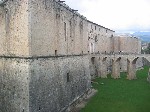 L'Aquila with approximately 72,000 inhabitants is the capital of the Abruzzo region (http://www.regione.abruzzo.it) in central Italy, and is conveniently located 100 km (62 miles) northeast of Rome. The city is on a hill at 720 m (2365 ft) above sea level and is surrounded by mountains, most notably to the north by the Gran Sasso (Big Rock) range that includes the highest peaks (up to 2900 m) of the Apennines, with a number of small lakes, trails and mountain climbing routes as well as deep caves.
Within the province of L’Aquila there are also two national parks (Il Parco
Nazionale Gran Sasso Monti della Laga and Parco Nazionale della Majella) and
one natural park (Parco Naturale Regionale Sirente Velino).
L'Aquila with approximately 72,000 inhabitants is the capital of the Abruzzo region (http://www.regione.abruzzo.it) in central Italy, and is conveniently located 100 km (62 miles) northeast of Rome. The city is on a hill at 720 m (2365 ft) above sea level and is surrounded by mountains, most notably to the north by the Gran Sasso (Big Rock) range that includes the highest peaks (up to 2900 m) of the Apennines, with a number of small lakes, trails and mountain climbing routes as well as deep caves.
Within the province of L’Aquila there are also two national parks (Il Parco
Nazionale Gran Sasso Monti della Laga and Parco Nazionale della Majella) and
one natural park (Parco Naturale Regionale Sirente Velino). The city of L’Aquila remains mainly unknown to the large number of tourists that visit Italy even though it has major attractions, such as the massive Spanish fortress erected in 1534 and shown below, that hosts the National Museum of Abruzzo (http://h1.ath.cx/muvi/museonazionaledabruzzo/), the Basilica of Collemaggio completed in 1288 that houses the tomb of Celestino V, the only Pope that resigned from the post, and the Fontana delle 99 Cannelle (99 Spouts Fountain, built in 1272). This fountain represents the various noble families that founded L’Aquila in the 12th century. As a result L’Aquila is a collection of many medieval buildings, churches and fountains, and if you leave the main avenues and follow the small streets you will find many beautiful views that have been captured brilliantly in Taro Ito’s aquarelles.
The city of L’Aquila remains mainly unknown to the large number of tourists that visit Italy even though it has major attractions, such as the massive Spanish fortress erected in 1534 and shown below, that hosts the National Museum of Abruzzo (http://h1.ath.cx/muvi/museonazionaledabruzzo/), the Basilica of Collemaggio completed in 1288 that houses the tomb of Celestino V, the only Pope that resigned from the post, and the Fontana delle 99 Cannelle (99 Spouts Fountain, built in 1272). This fountain represents the various noble families that founded L’Aquila in the 12th century. As a result L’Aquila is a collection of many medieval buildings, churches and fountains, and if you leave the main avenues and follow the small streets you will find many beautiful views that have been captured brilliantly in Taro Ito’s aquarelles.From a scientific point of view, L’Aquila is known for the University (http://www.univaq.it/), its origins dating back to the 15th century, and the National Laboratories of the Gran Sasso (http://www.lngs.infn.it/) that house a number of international experiments.



